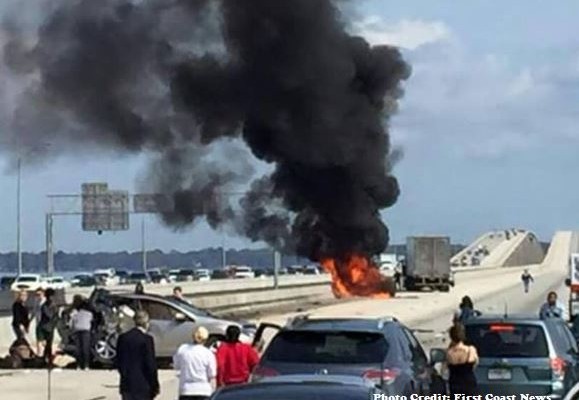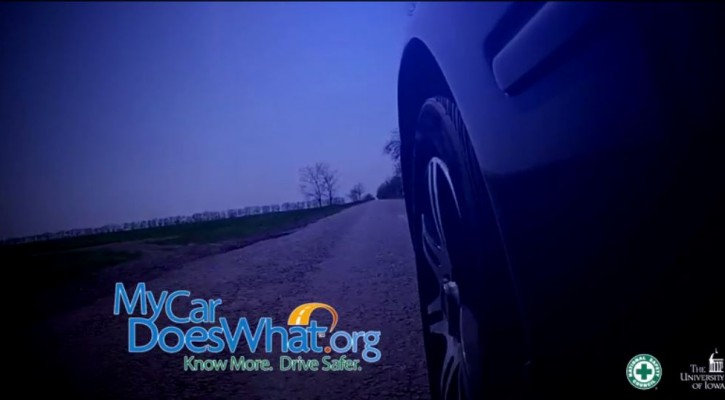
Careless Driving – Not Design – Responsible For Bridge Crashes
August 3, 2015
After several horrible crashes on Jacksonville Florida’s Buckman bridge, the Florida DOT conducted a study that found that careless driving and speed were responsible for crashes on the bridge, not the bridge design.
The call for the study came after two crashes in the past year made people question the safety of the large span across the St. John’s River. In the first crash, a small truck was sent over the guardrail and into the river. A Navy and police diver search located the driver’s body several hours later. In another crash in March of this year, a disabled SUV was struck by a semi and burst into flames, killing a mother and her three children.
The pickup crash into the river was not the first time a vehicle had gone over the railing into the river and the latest crash caused local residents and officials to question whether the railings on the bridge were high enough. The Florida Department of Transportation (FDOT) was tasked with conducting the study.
In the study, released by FDOT last week, the researchers looked at the previous five year history of crashes, both on the bridge and stretches of I-295 approaching each end. The researchers concluded that the structure of the eight-lane, three mile long double span met all safety requirements and didn’t contribute to the crashes, either on or adjacent to the bridge.
Instead, the researchers blamed careless driving and high speeds for the crashes. In their study, the researchers monitored average speeds throughout the day. In spite of the posted 65 mph speed limit, the researchers said that drivers drive at an average of 72 mph on the bridge.
Careless driving and distracted drivers also play a big part in the crashes on the bridge. In the crash that sent the pickup truck into the river, police reported that a distracted driver swerved to avoid hitting the car ahead and clipped the pickup truck sending it spinning over the bridge railing.
In the crash involving the family, as a driver behind the stalled SUV slowed to a stop, it was hit from behind by the driver of a large truck. As the first vehicle spun out of the lane, the truck plowed ahead and hit the SUV sending it into the guardrail where it burst into flames.
We have written before that there is no such thing as a motor vehicle “accident.” Accidents are something we have no control over. Motor vehicle crashes are caused by drivers who make a fatal error, such as; speeding, driving under the influence, or not paying attention to the road ahead.
Speed causes problems because a speeding driver has very little time to react when encountering a problem in the road ahead. Speeding also increases the impact forces in a crash.
A bridge like the Buckman carries a tremendous amount of traffic and, along with speeding drivers, there are slow drivers (probably on a cell phone) and drivers weaving in and out of lanes. The bridge has a high hump in the middle to allow for boat traffic and, if there’s an obstruction or problem ahead, a speeding, distracted driver won’t realize it until it’s too late. If ever there was a time to ignore the distractions and concentrate on the road ahead, it’s on a bridge like this one.
Speeding and distracted drivers, along with all the other drivers are trapped within the confines of the bridge and, should a problem occur ahead, there’s no room to escape. Drivers need to maintain a safe following distance of at least two seconds and watch, not only at what’s directly in front, but also as far down the road as possible. When driving over the hump, drivers should anticipate the possibility of problems ahead and give themselves extra room to maneuver or stop.
The only recommendations made by the researchers were for greater enforcement of the speed limit and for electric signs ahead of the bridge to warn of crashes or stalled vehicles on the bridge.
Read more: FDOT releases findings on Buckman Bridge crashes
Photo credit: First Coast News

Rural Roads More Dangerous Than Urban Roads
July 31, 2015
When thinking of rural or country areas, most people imagine a laid back, slower lifestyle but, while that stereotype might work for the local country diner, it doesn’t hold true for rural roads. The latest data is out from the National Highway Transportation Safety Administration (NHTSA) for the 2013 calendar year and it shows that, just like in years past, more people die in in motor vehicle crashes in rural areas than urban areas.
While most people may think that interstate highways are the most dangerous type of road, it’s actually rural roads where the majority of fatal crashes happen.
|
Type of road |
Number of fatal crashes |
Number of deaths |
|
Urban |
14,026 |
14,987 |
|
Rural |
15,998 |
17,696 |
According to the 2013 American Community Survey from the U.S. Census Bureau, an estimated 19 percent of the U.S. population lived in rural areas. However, rural fatalities accounted for 54 percent of all traffic fatalities in 2013.
Why so many deaths in such sparsely populated areas? There are several factors that contribute to the high death toll on rural roads:
Roads
Most rural roads are generally two-lane, narrow roads. In the east and far west, they tend to be hilly, winding roads with narrow shoulders that limit a driver’s view ahead and give the driver very limited room to escape in case of a hazard on the road.
Speed
The combination of those hilly, winding roads and high speed can be deadly. Thirty percent of those killed in rural crashes were speeding at the time of the crash. Speeding drivers may not be able to maintain control of the vehicle in a curve or stop in time if they encounter an object or other vehicle in the road. In rural fatal crashes, 69 percent of drivers involved were on roadways where the posted speed limit was 55 mph or higher.
Alcohol
Of all the alcohol involved fatal crashes in 2013, 54 percent occurred in rural areas.
Seat belts
Fifty-one percent of all rural passenger vehicle occupants who were killed in traffic crashes weren’t wearing a seat belt. The numbers go even higher depending on the type of vehicle driven;
- In light trucks, 60 percent of rural fatalities weren’t wearing a seat belt.
- In pickup trucks, 64 percent of rural fatalities weren’t wearing a seat belt.
- In SUV’s 58 percent of rural fatalities weren’t wearing a seat belt.
- Sixty-nine percent of rural passenger vehicle occupants killed in roll-over crashes weren’t wearing a seat belt.
When driving in rural areas, drivers should be aware that rural roads can be deadlier than urban interstates and they should gauge their speed by road conditions – not the speed limit and always wear a seat belt.
For more information, read: Traffic Safety Facts – Rural/Urban Comparison

Why Hands Free Phones Aren’t Safer For Drivers
July 28, 2015
Hands free phones aren’t any safer for drivers than hand held phones according to research from Carnegie Mellon University.
Cars are becoming more and more connected to the web with dashboard screens that essentially act as a built in smartphone with many of the features seen in a typical computer. Auto manufacturers say they’re providing what the customer wants but, while cars are being made safer in other areas, the addition of these web connected devices are creating the potential for even more distracted drivers on the road. The manufacturers are also pushing the idea that hands free phones and texting are safer than using handheld devices but the scientific evidence doesn’t back that up.
In 2008, the Carnegie Mellon Center for Cognitive Brain Imaging published a study that used brain imaging to see what actually goes on in the brain while a driver is engaged in a phone conversation.
To conduct the study, 29 volunteer subjects “drove” over a simulated driving course while inside an MRI brain scanner. The subjects had to maintain speed while steering along a winding course. For the first test, the test subjects drove the course without any interruptions. In the second test, the subjects had to drive the course while listening to and answering true or false questions.
While driving without interruptions, the area of the brain that showed the greatest activity was the area responsible for “spatial awareness”; the area of the brain most associated with the complex task of safely steering a car
When the subjects had to listen and answer questions while driving, the activity in the brain’s spatial awareness area was reduced by 37 percent and the area of the brain associated with language comprehension showed the greatest activity.
In spite of all the modern day hubbub about the ability to multitask, the results of the study convinced the researchers that the brain itself isn’t capable of multitasking. The brain has to ignore other demands in order to do one task effectively.
If someone is using a phone while driving, whether it be a handheld or hands free phone, the brain is concentrating on the content of the call, not on the task of driving. When activity in the area of the brain responsible for steering a car and watching the road is reduced, it can be easy to miss a potentially hazardous situation ahead and that can lead to tragedy.
Other, more recent studies have shown that voice activated phone and texting systems such as Apple’s Siri or Google’s voice activated search can be even more distracting than using a hand held phone because of the frustrations experienced when the system fails to understand your requests. Studies also show that the distractions of smartphone notifications, even when they aren’t answered, can lead to driving mistakes.
The best advice for drivers who want to complete their trip safely is to turn off the phone while driving and, if a call must be made, pull off of the road.
Read more: Carnegie Mellon Study Shows Just Listening To Cell Phones Significantly Impairs Drivers

Cell Phone Notifications Are A Distraction Too
July 23, 2015
We all know that talking on a cell phone or reading and sending text messages while driving is a major distraction for drivers but it turns out that just receiving notifications are distracting too, even if the phone calls or texts aren’t answered or read.
This finding was described in a study conducted by researchers at Florida State University (FSU) and published in the Journal of Experimental Psychology: Human Perception and Performance.
To conduct their study, the FSU researchers had volunteers participate in a computerized exercise to determine their ability to concentrate and complete assigned tasks. Once that test had been completed and the results recorded, the volunteers were given the test again. In the second test, the volunteers were randomly assigned to three groups; no notifications, call, or text.
During the second exercise, the researchers called or sent text messages to the assigned volunteers. The volunteers weren’t aware that the calls and texts were part of the study or that the notifications were generated by the researchers.
The results showed that, even though they didn’t respond to the calls or texts, those volunteers who heard or felt the vibrations from the call or text notifications made more mistakes on their computerized tasks than those who didn’t receive any notifications. The results showed that, among those who received a notification, their chances of making a mistake were three times greater than those who didn’t receive any notifications.
According to the researchers, the study shows that the notifications were enough to distract an individual from concentrating on the task at hand. Comparing their data to other studies on the subject, the researchers concluded that just receiving notifications can be as distracting as actually answering the phone or a text.
While not tied specifically to driving, the study shows that drivers, especially those who may find themselves in situations where their concentration is needed most (construction zones, narrow roads with heavy traffic, etc.), could possibly be distracted enough by phone notifications to make a critical mistake on the road.
For drivers, the best bet is to turn the cell phone off while driving.
Read more: Cell phone alerts may be driving you to distraction

My Car Does What Offers Info On New Car Safety Technology
July 22, 2015
For those with a new car or those considering the purchase of a new car, My Car Does What.org offers an explanation of new car safety technologies available in new vehicles, including some that buyers may not have been aware were available.
Funded by the Toyota Safety Research and Education Program Settlement the site was developed by the National Safety Council and the University of Iowa. With new car safety technologies entering the market at a rapid pace and older technologies being updated, the website is designed to inform vehicle owners about the different technologies and teach drivers how to use them.
A lot of new car safety technology is getting a lot of press such as crash avoidance and lane departure systems but some new safety systems may be surprising to drivers including:
- Terrain management – adjusts speed and suspension systems when moving from paved to unpaved roads.
- Hill descent assist – aids drivers balance the need between braking and speed depending on the degree of the downhill grade.
- Hill start assist – When stopped facing uphill, keeps the car from rolling back by holding the brake until the gas pedal is activated.
- Health and workload monitoring – Monitors a driver’s vital signs and can alter car functions during a health emergency.
- Cornering braking control – Adjusts the brakes independently to keep the car on the road if a driver is approaching a sharp curve or corner too fast.
Other explanations of new and updated car safety systems include:
- Anti-lock braking
- Forward collision warning
- Adaptive and active suspension
- Adaptive headlights
- Automatic emergency braking
- Electronic braking assistance
- Obstacle detection
- Pedestrian detection
- High speed alert
- Adaptive headlights
- Night vision
- Adaptive cruise control
- Tire pressure monitoring
- Road surface warning
- Back-up cameras
- Lane departure warning
The actual list of features is much longer and the website includes both written explanations and videos on each car safety system. It also includes information on auto safety research.
Read more: My Car Does What.org
